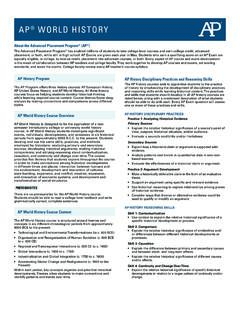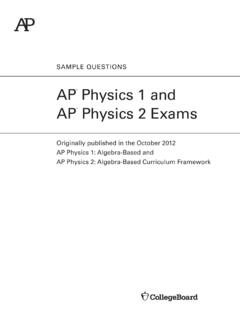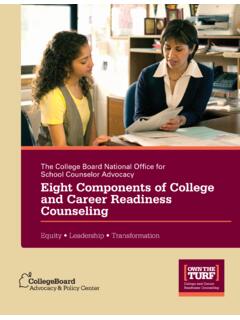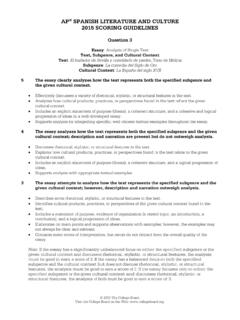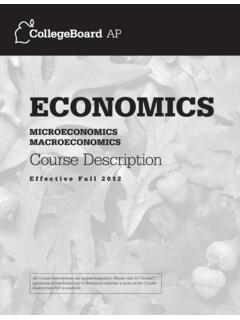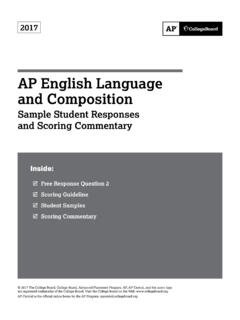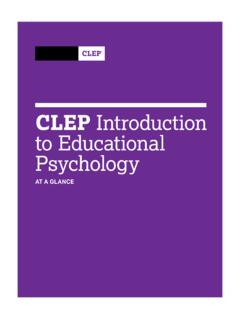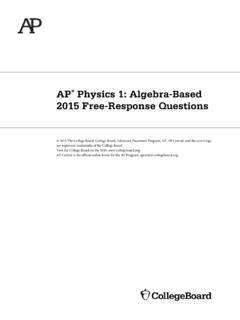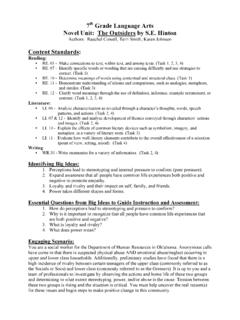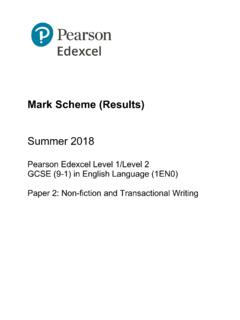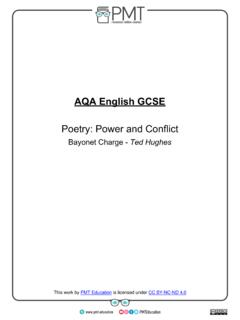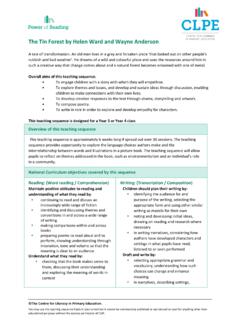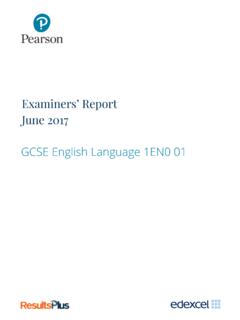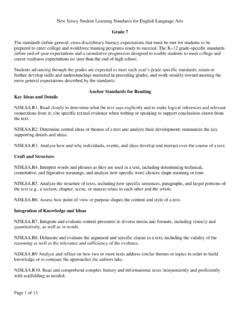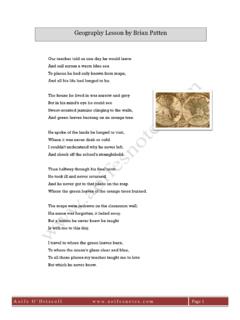Transcription of AP ENGLISH LANGUAGE AND COMPOSITION 2010 SCORING …
1 AP ENGLISH LANGUAGE AND COMPOSITION . 2010 SCORING GUIDELINES. Question 2. The score should reflect a judgment of the essay's quality as a whole. Remember that students had only 40 minutes to read and write; the essay, therefore, is not a finished product and should not be judged by standards appropriate for an out-of-class assignment. Evaluate the essay as a draft, making certain to reward students for what they do well. All essays, even those scored 8 or 9, may contain occasional lapses in analysis, prose style or mechanics. Such features should enter into the holistic evaluation of an essay's overall quality. In no case may an essay with many distracting errors in grammar and mechanics be scored higher than a 2.
2 _____. 9 Essays earning a score of 9 meet the criteria for a score of 8 and, in addition, are especially sophisticated in their argument, thorough in their development or impressive in their control of LANGUAGE . 8 Effective Essays earning a score of 8 effectively analyze* how Banneker uses rhetorical strategies to argue against slavery. They develop their analysis with evidence and explanations that are appropriate and convincing, referring to the passage explicitly or implicitly. The prose demonstrates a consistent ability to control a wide range of the elements of effective writing but is not necessarily flawless. 7 Essays earning a score of 7 meet the criteria for a score of 6 but provide more complete explanation, more thorough development or a more mature prose style.
3 6 Adequate Essays earning a score of 6 adequately analyze how Banneker uses rhetorical strategies to argue against slavery. They develop their analysis with evidence and explanations that are appropriate and sufficient, referring to the passage explicitly or implicitly. The writing may contain lapses in diction or syntax, but generally the prose is clear. 5 Essays earning a score of 5 analyze how Banneker uses rhetorical strategies to argue against slavery. The evidence or explanations used may be uneven, inconsistent or limited. The writing may contain lapses in diction or syntax, but it usually conveys the student's ideas. 4 Inadequate Essays earning a score of 4 inadequately analyze how Banneker uses rhetorical strategies to argue against slavery.
4 These essays may misunderstand the passage, misrepresent the strategies Banneker uses or analyze these strategies inaccurately. The evidence or explanations used may be inappropriate, insufficient or less convincing. The prose generally conveys the student's ideas but may be less consistent in controlling the elements of effective writing. _____. * For the purposes of SCORING , analysis refers to identifying features of a text and explaining how the author uses these to develop the meaning or to achieve a particular effect or purpose. 2010 The College Board. Visit the College Board on the Web: AP ENGLISH LANGUAGE AND COMPOSITION . 2010 SCORING GUIDELINES. Question 2 (continued). 3 Essays earning a score of 3 meet the criteria for a score of 4 but demonstrate less success in analyzing Banneker's use of rhetorical strategies to argue against slavery.
5 They are less perceptive in their understanding of the passage or Banneker's strategies, or the explanation or examples may be particularly limited or simplistic. The essays may show less maturity in control of writing. 2 Little Success Essays earning a score of 2 demonstrate little success in analyzing how Banneker uses rhetorical strategies to argue against slavery. These essays may misunderstand the prompt, misread the passage, fail to analyze the strategies Banneker uses, or substitute a simpler task by responding to the prompt tangentially with unrelated, inaccurate or inappropriate explanation. The prose often demonstrates consistent weaknesses in writing, such as grammatical problems, a lack of development or organization, or a lack of control.
6 1 Essays earning a score of 1 meet the criteria for a score of 2 but are undeveloped, especially simplistic in their explanation or weak in their control of LANGUAGE . 0 Indicates an on-topic response that receives no credit, such as one that merely repeats the prompt. Indicates a blank response or one that is completely off topic. 2010 The College Board. Visit the College Board on the Web: 2010 The College Board. Visit the College Board on the Web: 2010 The College Board. Visit the College Board on the Web: 2010 The College Board. Visit the College Board on the Web: 2010 The College Board. Visit the College Board on the Web: 2010 The College Board. Visit the College Board on the Web: 2010 The College Board. Visit the College Board on the Web: 2010 The College Board.
7 Visit the College Board on the Web: AP ENGLISH LANGUAGE AND COMPOSITION . 2010 SCORING COMMENTARY. Question 2. Overview This question examined students' ability to engage in close reading and rhetorical analysis of a piece of nonfiction prose that is, their ability to explain the meaning, purpose and effect of a passage and the rhetorical strategies the author employed to convey meaning, achieve purpose and create an effect. In particular, students were asked to read and analyze an excerpt of a letter written to Thomas Jefferson in 1791 by Benjamin Banneker, the son of former slaves and a successful farmer, astronomer, mathematician, surveyor and author. Students were directed to write an essay that analyzes how Banneker uses rhetorical strategies to argue against slavery.
8 Sample: 2A. Score: 8. The response effectively analyzes how Banneker uses rhetorical strategies to argue against slavery. It presents a specific introduction with clear intent: During this struggle Benjamin Banneker took a huge step and wrote Thomas Jefferson about his negative feelings on the issue of slavery in which he implemented several religious appeals, repetition, and an array of emotional diction. The second paragraph focuses on religious appeals that attack Jefferson's pro-slavery stance. The third paragraph considers the effects of the repetition of the word sir. The fourth paragraph discusses the effects of Banneker's emotional diction. The analysis is developed with evidence and explanations that are appropriate and convincing, and the student refers explicitly to the passage throughout the essay.
9 The response effectively concludes: Banneker vividly depicts what Jefferson's actions are doing to real life people which is intended to instil [sic] some much needed guilt as well as calling for a radical and instrumental change. Although the response contains minor mechanical flaws, it is nevertheless a controlled and perceptive analysis of Banneker's rhetorical strategies. Sample: 2B. Score: 5. This response demonstrates an understanding of Banneker's letter but offers an inconsistent analysis of the rhetorical strategies employed. The essay focuses on devices more than meaning, and it is organized in terms of devices. The third paragraph begins with an unclear claim about understatement but then presents a quotation and adequately comments on the text: This statement purposefully makes readers think about the awful situations that slaves endure as a result of the institution without outright stating those situations and making a big deal out of it.
10 In the fifth paragraph the response recognizes Banneker's use of important and reputable sources: the Declaration of Independence and the Bible to present the logical appeal. However, the analysis in the fourth paragraph of Banneker's use of hyperbole is less convincing: Of course our freedoms in America are due to the documents written by our founding fathers, not due to Heaven.' With uneven evidence and explanations, the response is developed minimally but is nevertheless sufficient and usually conveys the student's ideas. Sample: 2C. Score: 2. The response demonstrates little success in analyzing how Banneker uses rhetorical strategies to argue against slavery. It identifies two rhetorical devices alliteration and parallelism but fails to analyze the rhetorical strategies Banneker uses.
